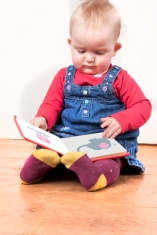 Even the youngest children enjoy listening to language. The coos and babbles that a baby makes are the beginnings of language development. You can help your child develop a love for reading and books with these 10 tips:
Even the youngest children enjoy listening to language. The coos and babbles that a baby makes are the beginnings of language development. You can help your child develop a love for reading and books with these 10 tips:
- Read daily. Take the time to read to your child every day. Reading aloud increases children’s vocabulary and fuels their imaginations. Read more than just books. Words are everywhere – signs, newspapers, letters, cards, menus, cereal boxes, recipes, etc.
- Read with enthusiasm in your voice! Use different tones to represent different characters in the story and ask your child to join in.
- Surround your child with books. Place them where she can access them easily. Don’t forget to keep a few favorites in the car and travel bag to take advantage of unexpected free time. Plan regular trips to the library, and utilize yard sales, thrift shops, and used book stores to help stock your shelves without spending a lot of money.
- Repeat favorites. Be willing to read your child’s favorite books over and over again. Children love being able to predict how the events of the story will unfold. In addition, the repetition helps your child become familiar with new words, letters, and language patterns. Your child may become so familiar with the book, he will be able to “read” it to you!
- Choose appropriate books. Consider your child’s age when picking out books.
 Board books, cloth, or plastic books are great for infants and toddlers because they are sturdy and can be easily cleaned. Make sure the books aren’t too long or too difficult for your child to understand. Pick topics that relate to events in your child’s life such as potty training, taking care of pets, a new baby, etc. Choose a variety of different books with interesting, repetitive, rhythmic, and fun text.
Board books, cloth, or plastic books are great for infants and toddlers because they are sturdy and can be easily cleaned. Make sure the books aren’t too long or too difficult for your child to understand. Pick topics that relate to events in your child’s life such as potty training, taking care of pets, a new baby, etc. Choose a variety of different books with interesting, repetitive, rhythmic, and fun text.
- Use your child’s name in print. This demonstrates how we use print and to help him learn to recognize his name and the letters in it.
- Be a reading role model. Let your child see you reading, making lists, and doing other literacy-related activities throughout your day. Talk about print and how you use it. (“The directions say to…”)
- Don’t force it. Too much pressure can actually push your child away. Instead, try some of the ideas mentioned here to naturally entice your child’s interest in reading.

- Allow interruptions. Encourage her to ask questions and make comments about the events of the story or the features of the illustrations. Ask your child questions such as, “What do you think will happen next? Can you find the butterfly in the picture? Do you remember what happened to the bear at the beginning of the book?”
- Continue reading! Once your child is able to read for herself, still take time to read her favorites to her. Not only does continued reading aloud strengthen listening skills and comprehension, it also makes your child feel loved and secure in your relationship together. Your child will remember the time you shared well into adulthood.
It’s never too late to start reading to your child! For inspiration and a treasury of titles to choose from, check out the classic book:
The Read-Aloud Handbook: Seventh Edition
by Jim Trelease
To read more about the fundamental aspects of early literacy, see our tips on Language Development and Writing Development.
Back to blog listing